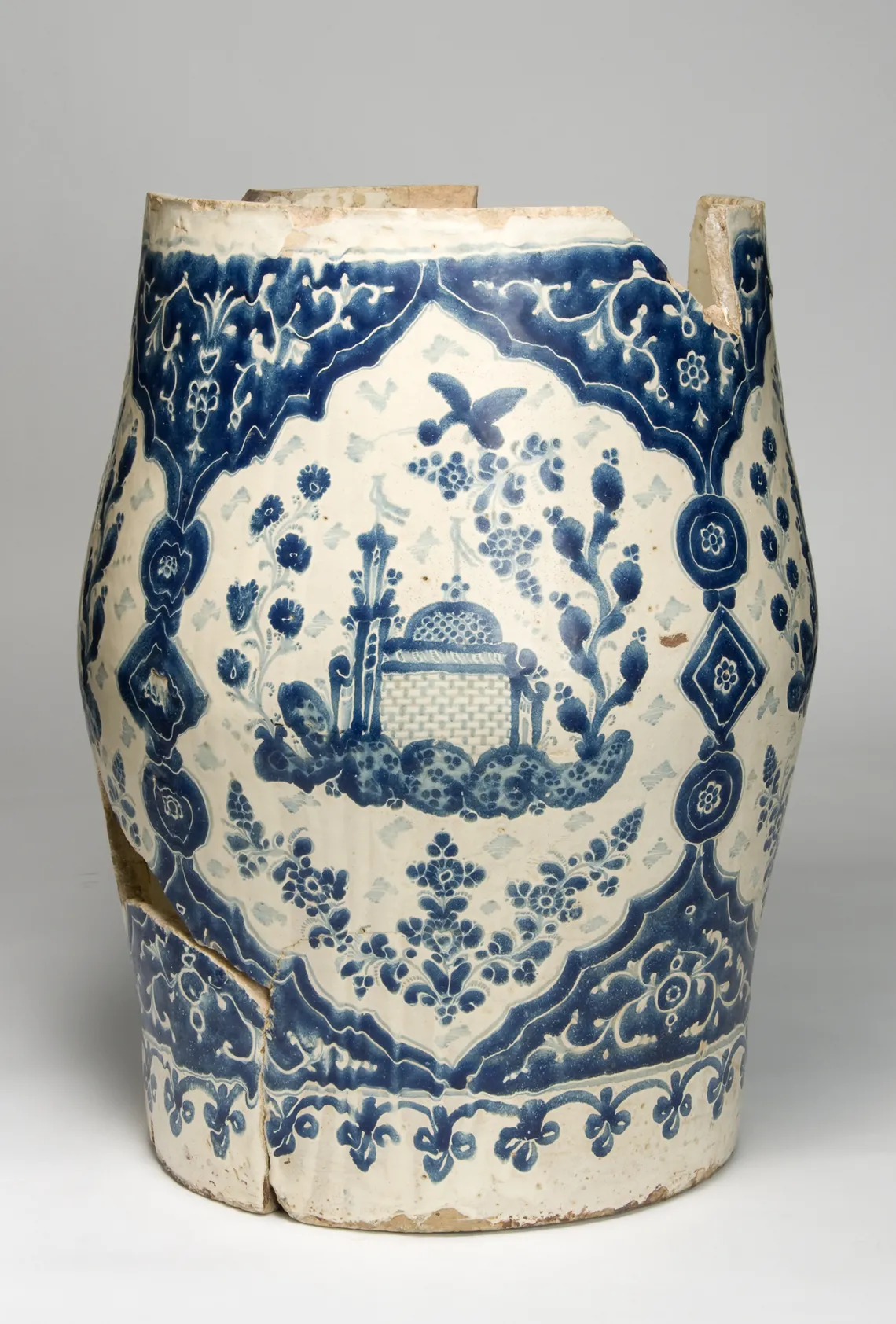
Majolica (Talavera) Barrel-shaped Jar (Barril)
18th Century
Puebla, Mexico
Earthenware with tin glaze and cobalt decoration
Height: 22.0 in. (56.0 cm.), Diameter: 17.4 in. (44.3 cm.)
Gift of Eman L. Beck Estate, 1961
(ASM Catalog No. E-4728)
The city of Puebla was founded in 1531 and a large number of churches were built in the region. This was part of the effort to convert Mexico’s indigenous peoples to the Catholic faith. Talavera pottery vessels and tiles (azulejos) were in high demand for outfitting churches and monasteries with baptismal fonts, holy water receptacles and architectural mosaics. Spanish and eventually indigenous and mestizo artisans produced this style of pottery. New designs were developed through the mixture of different traditions.
In the middle of the 17th century, a potters’ guild was formed in Puebla and ordinances were enacted regulating the production of Majolica ceramics. Typically a signature was required on the bottom each vessel, with the logo and the location of the manufacturer in Puebla. Multiple pottery forms and tiles emerged from these guilds in large quantities for daily uses and architectural embellishment.
Unfortunately this jar has no signature, but it clearly led a long and useful life. The distinctive barrel shape was inspired by a Chinese form that could have been a seat or a jardinière (planter) depending upon its size. It likely served as a planter because of the hole drilled in the bottom.
Talavera has a distinctive thick white "enamel" background glaze, and designs painted primarily in cobalt blue. Other colors including green, yellow, orange and black were also employed. To create this type of pottery, specific black and white clays from around Puebla are combined. The clay is washed and screened to retain only the finest particles. The clay is then shaped into form on a potter's wheel or in a mold. After drying for up to two months, the ceramic is fired in a kiln, or horno. A lead and tin glaze is applied that achieves the opaque, milky-white background. Designs are then painted in selected colors with mineral based paints. A second firing is required to vitrify the glaze and to seal the designs.
Influences on Mexican Majolica
The blue-on-white designs on the jar display the beauty of Arabic architecture infused with Chinese-inspired floral scenes. Moorish influence can be seen in the dome-shaped architecture—a mosque or church—and mosaic designs. Because of the distinctive iconography and the barrel form, the jar is estimated to date from around the middle of the 18th century.
Many Talavera shapes and decorative treatments were inspired by Chinese imports coming to Mexico from the Manila Galleons that arrived in Acapulco beginning in the 16th century. Chinese glazed pottery forms and designs were soon reinterpreted in Mexico. The form of this jar is Chinese inspired, as are the floral designs and the inclusion of an architectural feature. As Robert and Florence Lister note in their book on Spanish and Mexican Majolica, “…Taoist temples and teahouses emerged from Mexican brushes as Catholic cathedrals” (Lister and Lister 2001: 85).
Provenience (Origin and History)
This jar came to the Arizona State Museum (ASM) in 1961, as part of a Mexican Colonial Period collection from the estate of Eman L. Beck. Born in Indiana around 1875–1880, Beck lived his adult life as an American expatriate in Mexico City. He purchased part of the Sopori Ranch—located west of Arivaca Junction in Santa Cruz County, Arizona—in 1944, for his wife, Mary Payne Beck who was suffering from tuberculosis. When he died, his grandson, W. Kent Newcomb arranged for Beck’s collection to come to ASM.
The Becks’ daughter, Sue was married to Mesoamerican archaeologist George Vaillant (1901–1945). Accession records do not indicate how Mr. Beck obtained the Majolica pottery in his collection. However, recent conversations with his grandson, retired Harvard physician, Dr. George Eman Vaillant, have added to our understanding of Beck’s life.
Beck moved to Mexico City in the 1920s, first selling American-made shoes and then acquiring a bank. According to his grandson, Beck had wonderful taste and enjoyed buying Mexican antiques, including religious works that had fallen out of favor in anticlerical Mexico and were readily available. When the church was restored to favor in Mexico he would often give the pieces back to the churches. The Mexican Colonial Period materials that ended up at ASM were those for which he received permission from the Mexican government to export to the United States.
The Sopori ranch, once owned by the Becks, has a very rich history. Spanish explorer, Captain Juan Bautista de Anza first ran cattle there beginning in the late 1700s. Other owners through the years have included the Ronstadts and the Eliases, Hispanic ranching families with roots stretching back many years. General Robert E. Lee’s grandnephew, Arthur, owned the ranch in the 1930s and was killed in a horse accident there. After Mary Payne Beck died, Eman Beck sold the ranch in 1950 to Hollywood mogul, Jack Warner. The Warners’ heirs sold Sopori Ranch in 1991 to real estate developer John Croll. Since then, there have been efforts both to develop it and to preserve it for its environmental and historical value.
The jar was donated to the museum with cracks and evidence of a previous restoration effort. Former ASM Curator of Exhibits, Ernest Leavitt further repaired it by filling in the missing portions with custom-shaped sections of unglazed, fired red clay. To prepare it for exhibition, ASM’S conservators have stabilized the jar, removing the added pieces because these did not enhance the piece structurally or aesthetically.
Why was this object chosen?
I selected this Majolica barril because I found the form and designs very striking. The jar tells us a story about ceramics of early Colonial times in Mexico, when one can observe the blending of distinctive Spanish, Arabic, Chinese and indigenous Mexican influences. Given its provenience, the jar also contributes to narratives regarding its collector, Eman L. Beck, Mexico City in the early 20th Century, and the history of southeastern Arizona.





